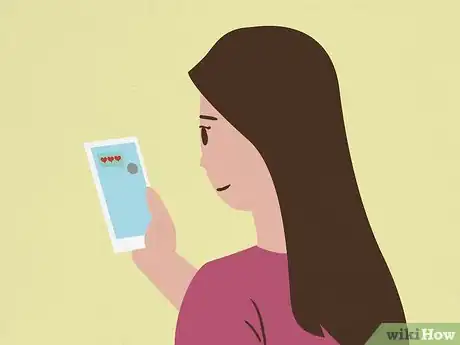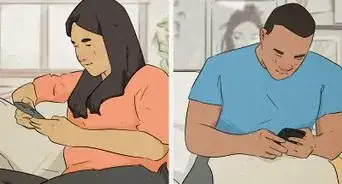This article was co-authored by Moshe Ratson, MFT, PCC. Moshe Ratson is the Executive Director of spiral2grow Marriage & Family Therapy, a coaching and therapy clinic in New York City. Moshe is an International Coach Federation accredited Professional Certified Coach (PCC). He received his MS in Marriage and Family Therapy from Iona College. Moshe is a clinical member of the American Association of Marriage and Family Therapy (AAMFT), and a member of the International Coach Federation (ICF).
There are 7 references cited in this article, which can be found at the bottom of the page.
This article has been viewed 24,336 times.
Not everyone is big on hugging, holding hands, or kissing to show affection. Some people feel uncomfortable with these forms of touching and might prefer to show affection for their loved ones in other ways. Luckily, there are several ways that you can do this. Start by identifying what your needs are regarding touching, and then share this information with anyone who might want physical contact with you. You can also demonstrate affection for people using your words and actions so they will know that you care.
Steps
Identifying and Communicating Your Needs
-
1Consider if there are any forms of touching that you like. This information may help you to determine if you’re willing to touch your significant other, friends, or family members in certain ways, such as holding their hand or patting them on the back. Try writing down any forms of touching that don’t seem to bother you.[1]
Tip: Remember that it’s also totally okay if you are not comfortable with touching at all. If that’s the case, it’s important to be honest with yourself and your loved ones about this preference.
-
2Identify types of touching that are the most uncomfortable for you. If there are certain types of touching that you absolutely hate, then it’s crucial to tell people this. You are not obligated to touch people in ways that make you feel uncomfortable. Write down any types of touching that you absolutely cannot stand and be as specific as possible about the types of touching you do not like.[2]
- For example, if you are bothered by the sensation of intertwining fingers while holding hands, then this is important information to give to anyone who wants to hold hands with you.
- Or, if you dislike the sensation of being hugged, anyone who might try to hug you will need to know this to avoid causing you any discomfort.
Advertisement -
3Decide if certain situations make touching more or less comfortable. Some people are more bothered by touching due to the circumstances or location, such as when touching occurs in a public setting or in front of other people. Tell your significant other, friends, and family members if you are bothered by public displays of affection in general or if certain types of PDA bother you while others don’t.[3]
- For example, if you are not comfortable with kissing or hugging while in public or in front of other people, then you might let your significant other know this.
-
4Share your preferences for touching with anyone who needs to know.[4] It’s important to talk with your significant other and any other loved ones who might want to know about your preferences. Choose a time to talk with the person when you will be alone. Let them know that touching makes you feel uncomfortable that you’d rather not show affection physically. If you’ve identified any types of touching that you are comfortable with, then you can specify what you find acceptable.[5]
- For example, you could say something like, “I am not comfortable with hugging. It’s nothing personal. It just makes me feel uncomfortable, so I’d rather we just shook hands when we see each other.”
- Or, you might say something like, “I know that you like to hold hands when we go on walks together, but I dislike the sensation of holding hands. I am fine with linking arms as an alternative.”
Showing Affection Verbally
-
1Tell the person how you feel about them. If you dislike showing physical affection, that’s okay! Instead, you could always tell the person how you feel about them. Whether it’s a family member, a friend, or your significant other, they will appreciate you saying something that indicates your affection for them.[6]
- Try saying something like, “Hey, Jared. I know I’m not very affectionate sometimes, but I want you to know that I like you a lot.”
- Or, you might say something like, “Hey mom. Even though I don’t like hugs, I love you. Just wanted to let you know!”
-
2Compliment the person on their positive traits or appearance.[7] Giving compliments is a classic way to show affection for someone without touching them. Try telling the person what you like most about them or noticing something new about their appearance when you see them. Make sure to offer genuine compliments and say why you appreciate that specific thing about the person.[8]
- Try saying something like, “You’re so funny! The stories you tell make me feel so happy.”
- Or, you could say, “That dress looks amazing on you! I admire your fashion sense so much.”
-
3Send them affectionate messages. Texting and direct messaging on social media are also good ways to show affection without touching. Try sending the person a text or direct message on days that you don’t see them just to let them know that you’re thinking about them. You could also include a smiley face, heart, or other friendly emoji to make it clear that you are showing affection for them.[9]
- For example, you could send your significant other a text that reads, “I miss you!” followed by a heart to show that you care about them.
- Or, you could simply send a loved one a text that reads, “I love you!” You could also add a heart or hug emoji, but there will likely be no mistaking that you are showing affection for them in a text like this.
-
4Write a love letter to tell them what you love about them.[10] If you enjoy writing, then this might be a fun way to express your feelings for a loved one. Try writing a love letter to a significant other, a parent or other family member, or even to your best friend to show them you care about them. Take at least 1 hour to compose your letter to the person and think about what you love best about them.[11]
- Make sure to write your letter as if you’re talking directly to the person. For example, you might start by writing, "Dear John, I love everything about you, but my favorite thing about you is..."
Tip: If you’re not into writing, you could also try drawing them a picture, making them a mix tape, or knitting them a scarf.
-
5Listen carefully to them and remember details about things they say. Being a good listener can help to demonstrate how much you care for the person. Pay close attention to the things that they tell you and try to remember details that you can bring up later on. This will show them that you really listen to them and that you care about the things they share with you.[12]
- For example, if your friend tells you about a problem they’re having with a family member one day, you could ask them about it the next time you see them.
- Or, if your significant other tells you about an idea they had for a short story, you might ask them about their progress on it the next time you see them.
Using Your Actions
-
1Do something kind and thoughtful for the person every day.[13] Look for little ways that you can brighten the person’s day, and this will let them know that you care about them. You don’t have to buy them things or go for grand gestures. Just look for small, thoughtful things that you can do for them.[14]
- For example, you could make them a cup of coffee just how they like it, put on their favorite TV show or movie when you’re relaxing together, or scrape their windshield off for them if it’s icy.
-
2Make time for them in your schedule even if you’re busy. Carving time out of your busy schedule for someone who is special to you is another great way to show affection for them. By making spending time with them a priority, they will know where they stand with you. You could even let them know that you value spending time with them so much that you are shifting things around in your schedule or that you are willing to give up something else to see them.[15]
- For example, you could say something like, “Jenny, I love spending time with you so much that I am going to go to the 5:30 am spin class instead of the 6:00 pm class”
- Or, you could say something like, “I have a crazy busy week, but I would never survive it without having a little quality time with you.”
-
3Help them when they’re having a problem. If a friend, family member, or significant other asks for your help, let them know that you are there for them and ask what you can do to help. This might be as simple as listening to them and being there for them if they need you, or they might need something more specific.[16]
- For example, if a friend calls or texts to tell you that their car has broken down, you could offer to give them a ride to school or work.
- If your significant other has lost something that’s important to them, you could stop what you’re doing and help them look.
Tip: Keep in mind that you don’t need to drop everything every time a loved one needs your help to show them you care. If you’re unable to help them right away, such as because you’re at work or busy with an issue of your own, just let them know that you will be there for them as soon as you can.
Expert Q&A
-
QuestionHow can I be more affectionate?
 Moshe Ratson, MFT, PCCMoshe Ratson is the Executive Director of spiral2grow Marriage & Family Therapy, a coaching and therapy clinic in New York City. Moshe is an International Coach Federation accredited Professional Certified Coach (PCC). He received his MS in Marriage and Family Therapy from Iona College. Moshe is a clinical member of the American Association of Marriage and Family Therapy (AAMFT), and a member of the International Coach Federation (ICF).
Moshe Ratson, MFT, PCCMoshe Ratson is the Executive Director of spiral2grow Marriage & Family Therapy, a coaching and therapy clinic in New York City. Moshe is an International Coach Federation accredited Professional Certified Coach (PCC). He received his MS in Marriage and Family Therapy from Iona College. Moshe is a clinical member of the American Association of Marriage and Family Therapy (AAMFT), and a member of the International Coach Federation (ICF).
Marriage & Family Therapist If you don't like touching, you can try giving compliments frequently, writing romantic notes, and going small acts of kindness.
If you don't like touching, you can try giving compliments frequently, writing romantic notes, and going small acts of kindness. -
QuestionHow do you show love in actions?
 Moshe Ratson, MFT, PCCMoshe Ratson is the Executive Director of spiral2grow Marriage & Family Therapy, a coaching and therapy clinic in New York City. Moshe is an International Coach Federation accredited Professional Certified Coach (PCC). He received his MS in Marriage and Family Therapy from Iona College. Moshe is a clinical member of the American Association of Marriage and Family Therapy (AAMFT), and a member of the International Coach Federation (ICF).
Moshe Ratson, MFT, PCCMoshe Ratson is the Executive Director of spiral2grow Marriage & Family Therapy, a coaching and therapy clinic in New York City. Moshe is an International Coach Federation accredited Professional Certified Coach (PCC). He received his MS in Marriage and Family Therapy from Iona College. Moshe is a clinical member of the American Association of Marriage and Family Therapy (AAMFT), and a member of the International Coach Federation (ICF).
Marriage & Family Therapist Do things for your partner. These can be special things, like buying your partner a gift or writing them a love note, or practical things like doing a chore for your partner.
Do things for your partner. These can be special things, like buying your partner a gift or writing them a love note, or practical things like doing a chore for your partner.
References
- ↑ https://www.glamour.com/story/how-when-and-where-guys-like-t
- ↑ https://www.glamour.com/story/how-when-and-where-guys-like-t
- ↑ https://www.glamour.com/story/how-when-and-where-guys-like-t
- ↑ Moshe Ratson, MFT, PCC. Marriage & Family Therapist. Expert Interview. 7 August 2019.
- ↑ https://www.goodtherapy.org/blog/dear-gt/help-my-partner-doesnt-like-to-be-touched
- ↑ https://hellogiggles.com/love-sex/relationships/little-ways-show-affection-to-your-partner/
- ↑ Moshe Ratson, MFT, PCC. Marriage & Family Therapist. Expert Interview. 7 August 2019.
- ↑ https://www.oprahmag.com/life/relationships-love/a28221845/how-to-give-compliments/
- ↑ https://greatergood.berkeley.edu/article/item/six_tips_for_reading_emotions_in_text_messages
- ↑ Moshe Ratson, MFT, PCC. Marriage & Family Therapist. Expert Interview. 7 August 2019.
- ↑ https://www.nytimes.com/2017/09/01/magazine/how-to-write-a-love-letter.html
- ↑ https://hellogiggles.com/love-sex/relationships/little-ways-show-affection-to-your-partner/
- ↑ Moshe Ratson, MFT, PCC. Marriage & Family Therapist. Expert Interview. 7 August 2019.
- ↑ https://hellogiggles.com/love-sex/relationships/little-ways-show-affection-to-your-partner/
- ↑ https://hellogiggles.com/love-sex/relationships/little-ways-show-affection-to-your-partner/
- ↑ https://hellogiggles.com/love-sex/relationships/little-ways-show-affection-to-your-partner/







































































